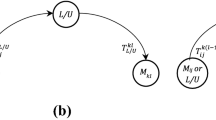Abstract
An automated manufacturing system (AMS) is a complex network of processing, inspecting, and buffering nodes connected by system of transportation mechanisms. For an AMS, it is desirable to be capable to increase or decrease the output with the rise and fall of demand. Such specifications show the complexity of decision making in the field of AMSs and the need for concise and accurate modeling methods. Therefore, in this paper, a flexible jobshop automated manufacturing system is proposed to optimize the material flow. The flexibility is on the multi-shops of the same type and also multiple products that can be produced. An automated guided vehicle is applied for material handling. The objective is to optimize the material flow regarding the demand fluctuations and machine specifications. An illustrative example is presented to test the validity of the proposed mathematical model.
Similar content being viewed by others
References
Aized T (2009) Modelling and performance maximization of an integrated automated guided vehicle system using coloured Petri net and response surface methods. Comput Ind Eng, Article (2009) Corrected Proof. doi:10.1016/j.cie.2009.02.009
Akella R, Krogh BH, Singh MR (1990) Efficient computation of coordinating controls in hierarchical structures for failure-prone multi-cell flexible assembly systems. IEEE Trans Robot Autom 6:659–672
Asef-Vaziri A, Dessouky M, Sriskandarajah C (2001) A loop material flow system design for automated guided vehicles. Int J Flex Manuf Sys 13:33–48
Berman S, Schechtman E, Edan Y (2009) Evaluation of automatic guided vehicle systems. Robot Comput-Integr Manuf 25(3):522–528
Bozer YA, Srinivasan MM (1992) Tandem AGV systems: a partitioning algorithm and performance comparison with conventional AGV systems. Eur J Oper Res 63:173–191
Castillo I, Reyes SA, Peters BA (2001) Modeling and analysis of tandem AGV systems using generalized stochastic Petri nets. J Manuf Syst 20(4):236–249
Demange M, Ekim T, de Werra D (2009) A tutorial on the use of graph coloring for some problems in robotics. Eur J Oper Res 192(1):41–55
Gen M, Lin L, Zhang H (2009) Evolutionary techniques for optimization problems in integrated manufacturing system: state-of-the-art-survey. Comput Ind Eng 56(3):779–808
Gershwin SB (1989) Hierarchical flow control: a framework for scheduling and planning discrete events in manufacturing systems. Proc IEEE 77:195–209
Ho YC, Liao TW (2009) Zone design and control for vehicle collision prevention and load balancing in a zone control AGV system. Comput Ind Eng 56(1):417–432
Huang Y, Liang C, Yang Y (2009) The optimum route problem by genetic algorithm for loading/unloading of yard crane. Comput Ind Eng 56(3):993–1001
Kaspi M, Kesselman U, Tanchoco JMA (2002) Optimal solution for the flow path design problem of a balanced unidirectional AGV system. Int J Prod Res 40:349–401
Laporte G, Zanjirani Farahani R, Miandoabchi E (2006) Designing an efficient method for tandem AGV network design problem using tabu search. Appl Math Comput 183:1410–1421
Rajagopalan S, Heragu SS, Taylor GD (2004) A Lagrangian relaxation approach to solving the integrated pick-up/drop-off point and AGV flow path design problem. Appl Math Model 28:735–750
Author information
Authors and Affiliations
Corresponding author
Additional information
This paper presents a method to optimize flow in a flexible jobshop manufacturing system. The material handling is done by AGV.
Also, a new approach to investigate the performance of the proposed shop is introduced.
Rights and permissions
About this article
Cite this article
Fazlollahtabar, H., Rezaie, B. & Kalantari, H. Mathematical programming approach to optimize material flow in an AGV-based flexible jobshop manufacturing system with performance analysis. Int J Adv Manuf Technol 51, 1149–1158 (2010). https://doi.org/10.1007/s00170-010-2700-9
Received:
Accepted:
Published:
Issue Date:
DOI: https://doi.org/10.1007/s00170-010-2700-9




